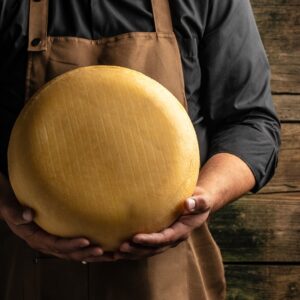
White Mould – Penicillium candidum
The Bloomy Rind Beauties
White moulds, primarily Penicillium candidum, also known as Penicillium camemberti, are responsible for the soft, velvety rinds of cheeses like Brie and Camembert. These moulds are typically sprayed onto the surface of the cheese, where they form a snowy white bloom that acts as both a protective rind and an active agent in ripening.
As the white mould grows, it breaks down fats and proteins in the cheese, softening the texture from the outside in and creating the buttery, creamy interior prized in bloomy-rind cheeses. It also imparts mild, mushroom-like notes and contributes to the signature white rind that is both edible and flavourful.
Available in 2 forms; traditional and vegan.
Additional information
| Weight | N/A |
|---|---|
| Dimensions | N/A |
| Type | Dairy, Non-Dairy Vegan |
Nature’s Alchemy of Flavour and Texture
In cheesemaking, moulds are more than just harmless fungi—they are vital agents of transformation. Carefully selected strains of mould are used to enhance flavour, develop texture, and create the distinctive appearances of many beloved cheeses. By introducing specific moulds at different stages of production, cheesemakers guide the ageing process, allowing the cheese to ripen from the surface or the interior in unique ways. Moulds help break down fats and proteins, unlocking a range of aromas and tastes that wouldn’t be possible in their absence. Far from being a flaw, mould is a celebrated feature in many cheese varieties, delivering everything from creamy softness to bold, tangy character.
Mould-ripened cheeses like Danish Blue, Gorgonzola, Camembert and Brie have long been favourites among cheese lovers, celebrated for their rich textures, complex flavours and characteristic appearances. But behind their creamy centres and tangy veins lies the fascinating science—and art—of moulds in cheesemaking. Far from being unwanted spoilage, specific moulds are intentionally introduced into cheeses to transform the milk curd into a deliciously ripened delicacy.
There are three main types of moulds used in cheese ripening: white, blue, and red. Each one plays a distinct role in flavour development, texture, and rind formation.
Moulds are not just passive additions; they are living cultures that actively transform the cheese from the outside or inside. By breaking down milk fats and proteins, they release a cascade of flavour compounds—nutty, buttery, earthy, tangy, or spicy, depending on the mould and ageing conditions.
Each variety of mould-ripened cheese offers a sensory experience shaped by tradition, environment and microbiology. Whether it’s the creamy decadence of Brie, the bold veins of Gorgonzola, or the pungent punch of a washed-rind wheel, moulds turn ordinary curds into extraordinary cheese.
So next time you slice into a wedge of Camembert or crumble some blue over a salad, you can thank the quiet work of moulds—nature’s own flavour-makers—for the delicious complexity they bring to your plate.



